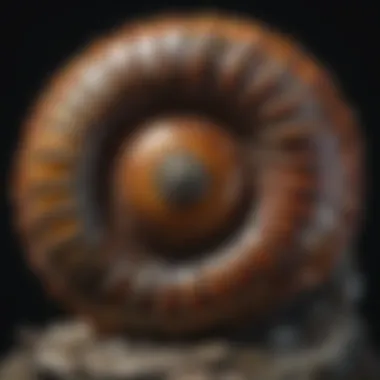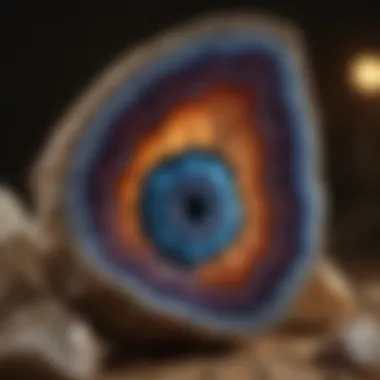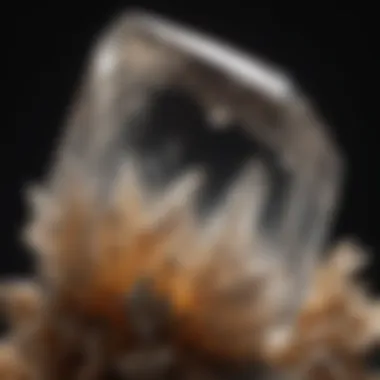Mastering Dremel Polishing for Rock and Fossil Collectors: Expert Guide


Rock and Fossil Identification
As rock and fossil collectors embark on their journey of dremel polishing, understanding the basics of rock and fossil identification becomes paramount. Differentiating between various types such as igneous, sedimentary, and metamorphic rocks, along with fossils like trace fossils, body fossils, and cast fossils, lays the foundation for successful polishing endeavors. Knowing the characteristics to look for, such as color, texture, and fossil imprints, aids in accurate identification. Utilizing tools like magnifying lenses, hardness picks, and UV lights enhances the identification process.
Collecting Tips and Techniques
When delving into the world of rock and fossil collection, adhering to best practices is essential. Collectors should scout prime sites that offer diverse specimens while respecting local regulations and permissions. Safely extracting specimens using chisels, hammers, and brushes preserves both the specimen and its surrounding environment. Implementing meticulous techniques ensures the integrity of collected rocks and fossils, setting the stage for successful dremel polishing sessions.
Preservation and Display
Preserving the integrity of rocks and fossils post-collection requires careful considerations. Employing techniques such as cleaning with gentle brushes and water, stabilizing with consolidants, and protecting from environmental factors like moisture and sunlight prolongs the lifespan of specimens. Optimal storage methods, including acid-free containers and padding materials, safeguard specimens from damage. Creative display ideas further elevate the aesthetic appeal of polished rocks and fossils, allowing collectors to showcase their prized pieces with elegance and flair.
Geological Insights
Diving deeper into the geological context surrounding rocks and fossils enriches the collector's understanding of their specimens. Exploring geological formations and processes that led to the creation of rocks and fossils provides valuable insights. Understanding the historical significance of certain specimens sheds light on ancient environments and life forms. Learning about notable discoveries in the field of geology and paleontology sparks curiosity and appreciation for the vast world of rocks and fossils.
Introduction to Dremel Polishing
In the realm of rock and fossil collecting, the art of Dremel polishing stands as a cornerstone technique, revered for its ability to enhance the natural beauty of geological specimens. Embracing this intricate craft requires not just skill but also a deep understanding of the tools, techniques, and safety precautions involved. As we delve into this comprehensive guide, collectors, both novice and seasoned, will uncover the secrets to elevating their specimens to new levels of splendor.
Understanding the Basics
Importance of Polishing in Rock and Fossil Collecting
When we contemplate the significance of polishing in rock and fossil collecting, a crucial realization dawns upon us. Polishing serves as the gateway to reveal the hidden magnificence within geological treasures, allowing collectors to unveil the intricate details and patterns that lie beneath the surface. This meticulous process not only enhances aesthetics but also enables a deeper appreciation of the earth's geological history, making it an indispensable practice for enthusiasts seeking to showcase the true essence of their specimens. The allure of polishing in rock and fossil collecting lies in its transformative power, turning rough fragments into polished masterpieces that captivate the eye and spark curiosity.
Overview of Dremel Rotary Tools
Central to the art of Dremel polishing are the versatile Dremel rotary tools, renowned for their precision and adaptability. These handheld devices serve as the craftsman's ultimate companion, enabling intricate detailing and controlled polishing with unparalleled finesse. The key characteristic of Dremel rotary tools lies in their ability to accommodate a wide array of accessories, from grinding stones to polishing wheels, making them a preferred choice for rock and fossil collectors seeking precision and efficiency. While the unique feature of Dremel rotary tools lies in their flexibility and ease of use, it's essential to acknowledge that mastering these tools requires patience and practice, ensuring optimal results in the art of polishing.


Safety Precautions
Protective Gear and Equipment
When engaging in Dremel polishing, prioritizing safety through the use of appropriate gear and equipment is paramount. Protective goggles, gloves, and masks shield the enthusiast from potential hazards, ensuring a secure environment for exploration and creativity. The key characteristic of protective gear and equipment lies in their ability to mitigate risks associated with flying debris and dust, safeguarding the collector's well-being during the polishing process. While the unique feature of protective gear and equipment is their role in fostering a safe and controlled workspace, one must also acknowledge the importance of investing in quality gear to guarantee maximum protection and comfort.
Ventilation and Workspace Setup
In the realm of Dremel polishing, proper ventilation and workspace setup play a pivotal role in ensuring a conducive working environment. Adequate ventilation diminishes the accumulation of harmful fumes and dust particles, promoting air quality and respiratory health during the polishing journey. The key characteristic of ventilation and workspace setup is their contribution to maintaining a clean and well-ventilated space, enhancing comfort and focus for the collector. While the unique feature of ventilation and workspace setup lies in its influence on overall safety and efficiency, collectors must prioritize organizing their workspace to optimize workflow and minimize distractions.
Choosing the Right Dremel Accessories
Grinding Stones and Polishing Wheels
Among the myriad choices faced by rock and fossil collectors, selecting the appropriate grinding stones and polishing wheels stands as a critical decision in the polishing process. These accessories are the unsung heroes behind achieving smooth finishes and intricate patterns, offering versatility and precision in shaping geological specimens. The key characteristic of grinding stones and polishing wheels is their abrasive quality, enabling collectors to refine surfaces and highlight details with finesse. While the unique feature of these accessories lies in their ability to withstand heavy use and deliver consistent results, collectors must discern the right grit and material composition to optimize their polishing endeavors.
Diamond Bits and Sanding Drums
In the arsenal of Dremel accessories, diamond bits and sanding drums emerge as indispensable tools for rock and fossil collectors venturing into the realm of polishing. The unparalleled hardness and durability of diamond bits make them ideal for intricate detailing and shaping, while the versatility of sanding drums allows for controlled material removal and surface smoothening. The key characteristic of diamond bits and sanding drums lies in their precision and efficiency, offering collectors the means to achieve professional-grade finishes on their geological specimens. While the unique feature of these accessories is their longevity and resilience, collectors must handle them with care to prolong their usefulness and maintain the quality of their polishing work.
Techniques for Effective Polishing
Effective polishing techniques are a cornerstone in the realm of rock and fossil collection. The meticulous process of polishing not only enhances the aesthetic appeal of geological specimens but also plays a pivotal role in their preservation. By employing the right techniques, collectors can elevate the natural beauty of rocks and fossils, showcasing them in all their splendor. Understanding the nuances of effective polishing is essential for enthusiasts looking to refine their craft and present their collections with finesse.
Pre-Polishing Preparation
Cleaning and Drying Specimens
Delving into the realm of pre-polishing preparation unveils the significance of cleaning and drying specimens. This critical step ensures that the surface of the rocks and fossils is free from contaminants, allowing for a pristine polishing process. The careful cleaning and subsequent drying of specimens set the foundation for a flawless polishing experience. The thoroughness of this step is crucial in attaining superior polishing results, as any impurities can hinder the overall outcome. While time-consuming, the attention to detail during cleaning and drying significantly contributes to the final presentation of the specimens.
Surface Inspection and Evaluation


Another integral aspect of pre-polishing preparation is surface inspection and evaluation. By scrutinizing the surface of the specimens, collectors can identify imperfections, cracks, or areas that require special attention during the polishing process. This meticulous evaluation ensures that each specimen receives tailored treatment, maximizing the polishing outcome. Understanding the surface intricacies of rocks and fossils guides collectors in applying specific polishing techniques to enhance the natural features effectively. Through detailed inspection and evaluation, collectors can streamline the polishing process, resulting in impeccable final displays.
Step-by-Step Polishing Process
Grinding and Shaping
The initial phase of the polishing journey involves grinding and shaping the specimens to achieve the desired form and smoothness. Utilizing precise tools and techniques, collectors can reshape rough surfaces, creating a canvas ready for polishing. Grinding aids in removing excess material, while shaping maintains the structural integrity of the specimens. This methodical approach sets the stage for subsequent polishing stages, ensuring a uniform and refined surface for intricate detailing.
Initial Polishing Stages
Transitioning from grinding, the initial polishing stages focus on laying the foundation for a flawless finish. Through progressively finer polishing agents, collectors can gradually enhance the luster of the specimens. Each stage refines the surface, unveiling the hidden beauty of rocks and fossils. Precision and patience are paramount during this phase, as meticulous attention to detail guarantees a stunning end result that captivates viewers.
Final Buffing and Shining
As the culmination of the polishing process, the final buffing and shining stage imparts a mesmerizing sheen to the specimens. Employing specialized techniques and compounds, collectors can achieve a mirror-like finish that accentuates the natural patterns and colors of the rocks and fossils. This last step in the polishing journey elevates the specimens to museum-quality standards, allowing collectors to exhibit their treasures with pride.
Advanced Polishing Techniques
Resin Impregnation for Enhanced Luster
One advanced technique to amplify the luster of geological specimens is resin impregnation. By permeating the porous surfaces of rocks and fossils with resin, collectors can achieve a heightened shine and depth of color. This technique not only enhances the visual appeal but also provides a protective seal, safeguarding the specimens for prolonged display. Resin impregnation is a popular choice among experienced collectors seeking to accentuate the intrinsic beauty of their geological finds.
Using Cerium Oxide for Mirror-Like Finishes
For collectors aiming to attain impeccable mirror-like finishes, utilizing cerium oxide proves to be a valuable technique. This rare-earth compound is renowned for its polishing prowess, capable of refining surfaces to a flawless glimmer. By applying cerium oxide with precision and care, collectors can transform ordinary rocks and fossils into exquisite marvels that gleam under light. The versatile nature of cerium oxide makes it a preferred choice for achieving professional-grade finishes that showcase the artistry of Dremel polishing with unparalleled brilliance.
Tips for Optimal Results
Achieving optimal results in Dremel polishing is critical for rock and fossil collectors seeking to showcase their geological specimens effectively. By adhering to expert tips and techniques, enthusiasts can elevate their polishing skills to professional levels. Understanding the importance of meticulous attention to detail and the proper use of tools can make a significant difference in the final presentation of specimens.


Maintaining Tool Performance
Maintaining the performance of Dremel accessories is paramount in ensuring consistent and high-quality polishing outcomes. Proper care and storage of tools play a vital role in prolonging their lifespan and functionality. By regularly cleaning accessories and storing them in designated compartments, collectors can prevent damage and maintain optimal working conditions for their Dremel tools.
Caring for Dremel Accessories
Caring for Dremel accessories involves keeping them clean and free from residue buildup, which can impact their performance. Regularly inspecting accessories for wear and tear and replacing them when necessary is essential for achieving precise and efficient polishing. Emphasizing proper maintenance not only enhances the longevity of accessories but also ensures smooth operation during the polishing process.
Troubleshooting Common Issues
Addressing common issues that arise during the polishing process is key to maintaining tool performance. Identifying problems such as overheating, vibration, or uneven polishing can help collectors take corrective actions promptly. By understanding common challenges and their root causes, enthusiasts can troubleshoot effectively and optimize the overall polishing experience.
Preservation and Display
Preserving geological specimens after polishing is crucial for maintaining their beauty and integrity over time. Applying protective coatings and implementing creative display ideas can enhance the longevity and visual appeal of rocks and fossils, allowing collectors to showcase them proudly.
Applying Protective Coatings
Applying protective coatings helps safeguard polished specimens from scratches, discoloration, and other forms of damage. Selecting the right type of coating based on the specimen's composition and finish is essential for optimal protection. By incorporating this step into their polishing routine, collectors can ensure the longevity and pristine appearance of their treasured specimens.
Creative Display Ideas
Exploring creative ways to display polished rocks and fossils adds a unique touch to any collection. From arranging specimens in themed showcases to incorporating lighting effects, collectors can enhance the visual impact of their displays. By experimenting with different presentation techniques, enthusiasts can create captivating displays that highlight the natural beauty and diversity of geological specimens.
Conclusion
In the realm of rock and fossil collecting, the conclusion plays a pivotal role in encapsulating the significance and essence of the entire polishing process. It acts as the final brushstroke, harmonizing the art of Dremel polishing with the geological specimens' intrinsic beauty. By delving into the conclusion, collectors can unveil a profound understanding of how meticulous polishing elevates the aesthetic appeal and longevity of their prized specimens. This segment serves as a beacon, guiding enthusiasts towards mastering the artistry of showcasing nature's wonders with precision and finesse.
Unlocking the Beauty of Geological Specimens
Embracing the art of Dremel polishing
Diving into the realm of embracing the art of Dremel polishing unveils a transformative journey for collectors. This intricate process intertwines precision, creativity, and passion in a mesmerizing symphony that breathes a new life into seemingly ordinary rocks and fossils. The key characteristic of this endeavor lies in its ability to unveil hidden splendors, delicately carved by nature's hands, through the skilled strokes of a Dremel tool. Embracing the art of Dremel polishing stands out as a beacon of innovation, revolutionizing how collectors perceive and present their geological treasures. The unique feature of this practice lies in its capability to infuse personality and craftsmanship into each polished masterpiece, thereby enhancing its allure and story. While the advantages are abundant, a careful balance must be struck to avoid over-polishing, which can diminish the specimen's authenticity and charm.
Showcasing the natural beauty of rocks and fossils
Venturing into showcasing the natural beauty of rocks and fossils opens a gateway to a mesmerizing display of Earth's history and artistry. The cornerstone of this aspect lies in magnifying the inherent splendor of geological specimens, turning them into captivating storytellers of bygone eras. Highlighting the unique hues, textures, and formations bestowed by geology's masterful hand amplifies the charm and educational value of each polished piece. Embracing this practice not only enhances the visual appeal but also fosters a deeper connection with the Earth's geological narrative, bridging the past with the present. The undisputed advantage of showcasing rocks and fossils in their true essence lies in enabling collectors to curate immersive exhibitions that spark curiosity and admiration. However, caution is warranted to preserve the specimens' integrity and authenticity amidst the allure of dramatic presentations.







